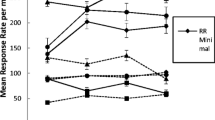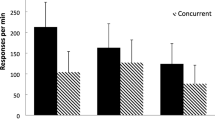Abstract
In order to investigate the effects of instructions describing features of schedules on choice under concurrent variableinterval schedules, 15 human subjects, in three groups, were exposed to five concurrent schedules. In addition to basic instructions describing a task, subjects in different groups received different additional instructions. Subjects in one group received instructions describing features of variable-interval schedules such as time-dependent programming and unpredictable availabilities of points (Instruction-S). Subjects in a second group received instructions describing frequencies of reinforcement obtained from two variable-interval schedules (Instruction-F). Subjects in a third group received both InstructionS and Instruction-F. In contrast to results reported in previous studies on human choice, most subjects showed systematic variations of choice ratios with reinforcement ratios. In addition, the slopes of the functions corresponding to the generalized matching law for the second and third groups were higher than those for the first group, indicating that Instruction-F had a stronger effect than Instruction-S. These results are consistent with the view that human choice conforms to the generalized matching law when subjects verbally formulate correct rules regarding concurrent variable-interval schedules.
Similar content being viewed by others
References
BAUM, W. M. (1974). On two types of deviation from the matching law: Bias and undermatching. Journal of the Experimental Analysis of Behavior, 22, 231–242.
BAUM, W. M. (1979). Matching, undermatching, and overmatching in studies of choice. Journal of the Experimental Analysis of Behavior, 23, 45–53.
BAUM, W. M. (1983). Comment: Matching, statistics, and common sense. Journal of the Experimental Analysis of Behavior, 39, 499–501.
BENTALL, R. P., LOWE, C. F., & BEASTY, A. (1985). The role of verbal behavior in human learning: II. Developmental differences. Journal of the Experimental Analysis of Behavior, 43, 165–181.
BRADSHAW, C. M., RUDDLE, H. V., & SZABADI, E. (1981). Studies of concurrent performances in humans. In C. M. Bradshaw, E. Szabadi, & C. F. Lowe (Eds.), Quantification of steady-state operant behaviour (pp. 79–90). Amsterdam: Elsevier/North-Holland Biomedical Press.
BRADSHAW, C. M., SZABADI, E., & BEVAN, P. (1976). Behavior of humans in variable-interval schedules of reinforcement. Journal of the Experimental Analysis of Behavior, 26, 135–141.
BRADSHAW, C. M., SZABADI, E., & BEVAN, P. (1979). The effect of punishment on free-operant choice behavior in humans. Journal of the Experimental Analysis of Behavior, 31, 71–81.
BRADSHAW, C. M., SZABADI, E., BEVAN, P., & RUDDLE, H. V. (1979). The effect of signaled reinforcement availability on concurrent performances in humans. Journal of the Experimental Analysis of Behavior, 32, 65–74.
CATANIA, A. C., & REYNOLDS, G. S. (1968). A quantitative analysis of the responding maintained by interval schedules of reinforcement. Journal of the Experimental Analysis of Behavior, 11, 327–383.
DE VILLIERS, P. (1977). Choice in concurrent schedules and a quantitative formulation of the law of effects. In W. K. Hoing & J. E. R. Staddon (Eds.), Handbook of operant behavior (pp. 233–287). Englewood Cliffs, NJ: Prentice-Hall.
GALIZIO, M. (1979). Contingency-shaped and rule-governed behavior: Instructional control of human loss avoidance. Journal of the Experimental Analysis of Behavior, 31, 53–70.
HERRNSTEIN, R. J. (1961). Relative and absolute strength of response as a function of frequency of reinforcement. Journal of the Experimental Analysis of Behavior, 4, 267–272.
HORNE, P. J., & LOWE, C. F. (1993). Determinants of human performances on concurrent schedules. Journal of the Experimental Analysis of Behavior, 59, 29–60.
LOWE, C. F. (1979). Determinants of human operant behaviour. In M. D. Zeiler & P. Harzem (Eds.), Advances in analysis of behaviour: Vol. I. Reinforcement and the organization of behaviour (pp.159–192). Chichester, England: Wiley.
MATTHEWS, B. A., SHIMOFF, E., CATANIA, A. C., & SAGVOLDEN, T. (1977). Uninstructed human responding: Sensitivity to ratio and interval contingencies. Journal of the Experimental Analysis of Behavior, 27, 453–467.
MYERS, D. L., & MYERS, L. E. (1977). Undermatching: A reappraisal of performance on concurrent variable-interval schedules. Journal of the Experimental Analysis of Behavior, 27, 203–214.
NAVARICK, D. J., & CHELLSEN, J. (1983). Matching versus undermatching in the choice behavior of humans. Behaviour Analysis Letters, 3, 325–335.
OSCAR-BERMAN, M., HEYMAN, G. M., BONNER, R. T., & RYDER, J. (1980). Human neuropsychology: Some differences between Korsakoff and normal operant performance. Psychological Research, 41, 235–247.
PIERCE, W. D., EPLING, W. F., & GREER, S. M. (1981). Human communication and the matching law. In C. M. Bradshaw, E. Szabadi, & C. F. Lowe (Eds.), Quantification of steady-state operant behaviour (pp. 345–352). Amsterdam: Elsevier/North-Holland Biomedical Press.
RUDDLE, H. V., BRADSHAW, C. M., & SZABADI, E. (1981). Performance of humans in variable-interval avoidance schedules programmed singly, and concurrently with variable-interval schedules of positive reinforcement. Quarterly Journal of Experimental Psychology, 33B, 213–226.
RUDDLE, H. V., BRADSHAW, C. M., SZABADI, E., & BEVAN, P. (1979). Behaviour of humans in concurrent schedules programmed on spatially separated operanda. Quarterly Journal of Experimental Psychology, 31, 509–517.
RUDDLE, H. v., BRADSHAW, C. M., Szabadi, E., & Foster, T. M. (1982). Performance of humans in concurrent avoidance/positive-reinforcement schedules. Journal of the Experimental Analysis of Behavior, 38, 51–61.
SCHMID, D. R. (1974). Effects of reinforcement rate and reinforcer magnitude on choice behavior of humans. Journal of the Experimental Analysis of Behavior, 21, 409–419.
SCHROEDER, S. R., & HOLLAND, J. G. (1969). Reinforcement of eye movement with concurrent schedules. Journal of the Experimental Analysis of Behavior, 12, 897–903.
TAKAHASHI, M., & IWAMOTO, T. (1986). Human concurrent performances: The effects of experiences, instructions, and schedule-correlated stimuli. Journal of the Experimental Analysis of Behavior, 45, 257–267.
WEARDEN, J. H., & BURGESS, I. S. (1982). Matching since Baum (1979). Journal of the Experimental Analysis of Behavior, 38, 339–348.
WEARDEN, J. H., & QUINN, R. R. (1982). Human performance under interresponse time contingencies. Behaviour Analysis Letters, 2, 309–319.
WURSTER, R. M., & GRIFFITHS, R. R. (1979). Human concurrent performances: Variation of reinforcer magnitude and rate of reinforcement. The Psychological Record, 29, 341–354.
Author information
Authors and Affiliations
Additional information
This research was supported by a Grant from the Ministry of Education of Japan (60790004).
We thank Prof. Takashige Iwamoto for his advice in planning the research.
Rights and permissions
About this article
Cite this article
Takahashi, M., Shimakura, T. The Effects Of Instructions On Human Matching. Psychol Rec 48, 171–181 (1998). https://doi.org/10.1007/BF03395264
Published:
Issue Date:
DOI: https://doi.org/10.1007/BF03395264




